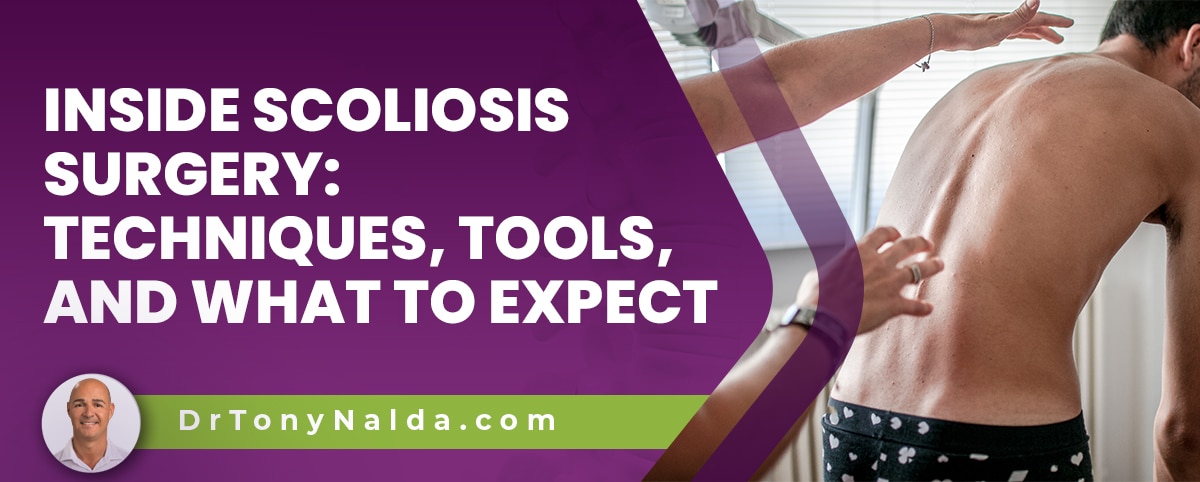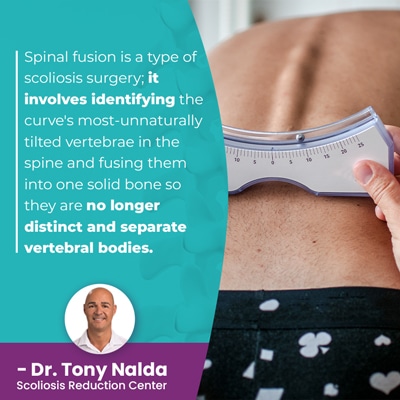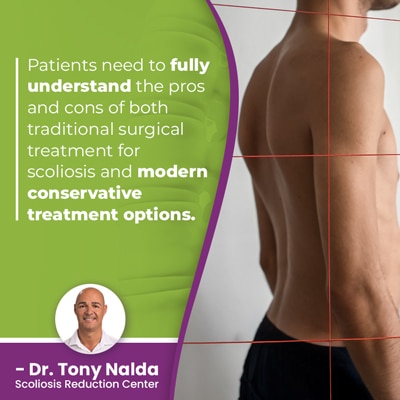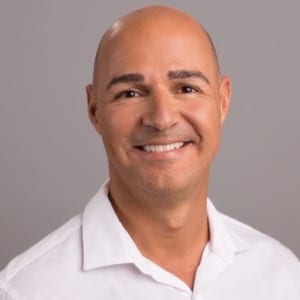Inside Scoliosis Surgery: Techniques, Tools, and What to Expect

It's hard to predict how a patient will respond to spinal fusion surgery; just as no two cases of scoliosis are the same, no two surgical responses are the same. There are also different types of spinal fusion, some considered less invasive than traditional spinal fusion: vertebral body tethering.
Scoliosis surgery is a type of spinal fusion, and like all spinal surgeries, it's invasive and can be risky. Spinal fusion surgery involves fusing the curve's most unnaturally-tilted vertebrae into one solid bone so the condition can't progress.
What patients need to understand is that there is more than one approach to treating scoliosis and not all cases require surgery.
Table of Contents
Treating a Complex Progressive Spinal Condition
Scoliosis is a complex progressive spinal condition that causes an unnatural sideways-bending spinal curve to develop that also rotates, making it 3-dimensional.
As a progressive condition, the nature of scoliosis is to become more severe over time, and counteracting the condition's progressive nature is a challenge of scoliosis treatment.
As it's progressive, scoliosis treatment is about managing an ongoing condition, and how a diagnosis of scoliosis is responded to with treatment can shape the spine's long-term strength and function; it's a choice that should be well-informed.
In addition, scoliosis ranges widely in severity from mild scoliosis to moderate scoliosis, severe and very severe cases, and there are also different types of scoliosis.
Types of Scoliosis
When it comes to condition type, this is determined by causation. The most common type of scoliosis to affect all ages is idiopathic scoliosis, meaning no known cause, and this accounts for approximately 80 percent of known cases.
Idiopathic scoliosis cases are typical and feature right-bending curves, but atypical types can feature left-bending curves, and this is more serious because the unnatural spinal curve is bending towards the heart, and this is atypical and is associated with known causes.
The remaining 20 percent of known types include neuromuscular scoliosis, degenerative scoliosis, and congenital scoliosis.
Condition type is particularly significant when it comes to treatment because a condition's underlying cause has to shape the crafting of treatment plans.
Idiopathic scoliosis is not clearly associated with a single-known cause; neuromuscular scoliosis cases can be among the most challenging to treat because the scoliosis develops as a secondary complication of a more serious neuromuscular condition.
Degenerative scoliosis is caused by natural age-related spinal degeneration so can involve the spine becoming increasingly unbalanced and unstable, and congenital scoliosis is caused by a malformed spine that develops in utero.
So in typical cases of idiopathic scoliosis, particularly those that were diagnosed and treated early, surgical options aren't always necessary, and the more atypical and severe a condition is, the more likely a surgical recommendation becomes.
What is Spinal Fusion?
 Spinal fusion is a type of scoliosis surgery; it involves identifying the curve's most-unnaturally tilted vertebrae in the spine and fusing them into one solid bone so they are no longer distinct and separate vertebral bodies.
Spinal fusion is a type of scoliosis surgery; it involves identifying the curve's most-unnaturally tilted vertebrae in the spine and fusing them into one solid bone so they are no longer distinct and separate vertebral bodies.
In most cases, the disc that sits between adjacent vertebrae is removed, and metal rods are attached to the spine to hold it in place.
Once a spine is fused, it's fused for life, and the goal is to stop the condition from progressing further because the vertebrae can't become more unnaturally-tilted over time.
If the fusion fails for any reason and more surgery is needed, surgical risks increase with each subsequent procedure and increasing age.
A less-invasive type of spinal fusion is known as vertebral body tethering (VBT), and this can be useful in patients who are having large growth spurts.
Vertebral Body Tethering
Vertebral body tethering uses fibers to secure the spine's position instead of metal rods and pedicle screws; the procedure involves making small incisions down one side of the body and accessing the spine through these portals.
A camera and scope are used for precise guidance, and screws are attached on the affected vertebrae which are then attached to a flexible tether, and the tethers can be adjusted as needed; this allows for adjustments to be made based on how a patient is growing and responding to treatment.
Known as growth modulation surgery for scoliosis, vertebral body tethering also involves less muscle cutting to access the spine so tends to be easier to recover from.
So now that we know how scoliosis surgery is performed, let's talk about some of its potential risks, side effects, and complications because surgery isn't the only answer.
Potential Spinal Fusion Risks, Side Effects, and Complications
Spinal fusion comes with some serious risks so should be considered carefully.
 Patients need to fully understand the pros and cons of both traditional surgical treatment for scoliosis and modern conservative treatment options.
Patients need to fully understand the pros and cons of both traditional surgical treatment for scoliosis and modern conservative treatment options.
Spinal fusion surgery itself comes with some potential risks: infection, nerve damage, excessive blood loss, and invasive reaction to hardware used.
While there is no way to predict how a patient will respond to spinal fusion, important factors include patient age, condition severity, type, location, and the number of vertebrae fused.
Potential side effects can include a spine that's less flexible and more painful at the fusion site, and this can mean living with activity restrictions, and in addition, a fused spine is going to be weaker and more vulnerable to injury.
Potential complications like hardware malfunctions are rare, but they do happen, and this can involve a rod breaking, cracking, or a screw coming loose, and the only recourse is more surgery.
There is also a gap in the research on the long-term effects of living with fused spine 30, 40, 50 years into the future, and keep in mind, the younger a patient is at the time of their spinal fusion, the longer the hardware has to last and perform optimally inside the body.
How is Scoliosis Treated Without Surgery?
For patients wanting to forgo a surgical recommendation or who simply want to try a less invasive treatment option first, modern conservative scoliosis treatment has a lot to offer.
Here at the Scoliosis Reduction Center®, patients benefit from a proactive nonsurgical treatment response that represents the culmination of what we've learned about the condition and treatment efficacy over the years.
An integrative approach involves combining the power of different facets of scoliosis treatment so conditions can be impacted on every level and treatment plans can be fully customized to address key patients and condition variables.
Conservative treatment doesn't just want to stop scoliosis from progressing, it wants to correct the condition on a structural level, and this is worked towards through chiropractic care that can realign the spine and restore as much of its healthy curves as possible.
The spine's structural changes have to be supported by strong and balanced muscles, and physical therapy and the prescription of scoliosis-specific exercises can help improve the spine's surrounding muscle strength and balance for more spinal support and stability.
Corrective bracing can also help by pushing the spine into a corrective position, and as growing spines are more malleable, bracing is a regular facet of childhood scoliosis treatment; in adult scoliosis, bracing is more about short-term pain management and spinal stability.
Rehabilitation is the ongoing portion of treatment that can involve lifestyle guidance and scoliosis home exercises to further heal and stabilize the spine.
Conclusion
Scoliosis surgery can be necessary for particularly severe and/or atypical cases, but the reality is that many cases of scoliosis can be addressed successfully without invasive surgical options.
Scoliosis surgery involves fusing the curve's most-tilted vertebrae into one solid bone, removing intervertebral discs that sit between, and attaching metal rods to the spine to maintain its alignment.
Vertebral body tethering is a less invasive type of spinal fusion; it accounts for growth as flexible tethers attached to the spine have their tension adjusted to apply changing amounts of pressure to the curve.
Vertebral body tethering spares muscles that would otherwise have to be cut through to access the spine, and the more muscle tissue that's cut, the more lengthy a patient's recovery time is expected to be.
Patients of the Center benefit from a multifaceted nonsurgical treatment approach that is chiropractic-centered and works towards preserving as much of the spine's natural strength and function as possible.
So if you or a loved one is diagnosed with scoliosis, don't hesitate to reach out for guidance and support; I want all scoliosis patients to be fully informed on all treatment options available to them.
Dr. Tony Nalda
DOCTOR OF CHIROPRACTIC
After receiving an undergraduate degree in psychology and his Doctorate of Chiropractic from Life University, Dr. Nalda settled in Celebration, Florida and proceeded to build one of Central Florida’s most successful chiropractic clinics.
His experience with patients suffering from scoliosis, and the confusion and frustration they faced, led him to seek a specialty in scoliosis care. In 2006 he completed his Intensive Care Certification from CLEAR Institute, a leading scoliosis educational and certification center.
About Dr. Tony Nalda
 Ready to explore scoliosis treatment? Contact Us Now
Ready to explore scoliosis treatment? Contact Us Now





